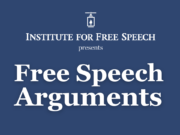Corporations are “distorting our democracy” – at least according to activists Bruce F. Freed and Marian Currinder, writing in U.S. News and World Report. The authors spin the usual tale of untold corporate billions flooding elections in the wake of the Supreme Court’s 2010’s Citizens United decision.
But it is just that – a tale. This is a story of how you misuse statistics, misrepresent the facts, and purposefully mislead your readers to confirm preconceived biases. Let’s dig in to the details – as we do, remember that Freed and Currinder’s contention is that after Citizens United, money spent by corporations is fundamentally changing how our democracy operates.
The primary, and most shocking, claim in the U.S. News piece is that “In the 2014 election cycle, business interests spent a staggering $1.1 billion on state candidates and committees. By comparison, in the same period labor groups spent $215 million and ideological or single-issue groups spent $137 million.” For those who work with data in this corner of the policy sphere every day, $1.1 billion in spending on state races by business simply does not pass the smell test. Consider that in the 2014 cycle, all spending by all federal House candidates was less than $1.1 billion.
So where does this number come from? Freed and Currinder link us to the National Institute on Money in State Politics (NIMSP) database.[1] This database has no section for “business interests,” but if you add up spending by all “broad sectors” as coded by NIMSP (things like “Health” and “Finance, Insurance and Real Estate”) and exclude the sectors “Labor” and “Ideology/single issue” the total comes to $1,143,463,317 – approximately the $1.1 billion figure the authors cite.
There are countless reasons why this calculation is a terrible way to present the data. Here are three of the biggest:
First, and most significantly, this method lumps together all contributions in every state from any individual and any group and assigns them to sector based on mandatory employer disclosure data. That is, if Hector Gonzalez of San Luis Obispo, California gives $250 to the campaign of a state senator he supports, his contribution is considered part of the “business interests” corrupting democracy, because California requires that he list his employer when contributing, and he works as an assistant manager at the local Wells Fargo. If you extract individual contributions like those of our hypothetical Mr. Gonzalez, the total amount of business spending drops by a staggering 350 million dollars.
If Freed and Currinder believe that individual donations, at least from wealthy (or not so wealthy) citizens, are fundamentally altering state politics, then it would be nice if they stated that explicitly. But they cannot blame recent Supreme Court decisions. The ability of individuals to voluntarily donate money to the campaigns of candidates and ballot measures has existed since we’ve had candidates and ballot measures – to pretend that engagement at the state level by corporations is a new phenomenon forced upon us by Citizens United is remarkably disingenuous.
But that’s just the first reason this statistic gives the wrong impression. Recall again Freed and Currinder’s claim that “business interests spent a staggering $1.1 billion on state candidates and committees.” Those last two words (“and committees”) turn out to carry tremendous weight. When reading that allegation, one comes away with the (likely intentional) impression that the contributions in question were to candidates, party committees, and political action committees – the three major types of groups doing work to elect and defeat candidates in this country. Unfortunately for readers looking to be informed, such an impression is inaccurate. Over $410 million of that $1.1 billion was spent on ballot measures in the states. This genuine issue advocacy, on anything ranging from GMO labeling in Colorado to a minimum wage increase in Arkansas, is not at all comparable to spending targeted at candidates. Quite simply, you cannot corrupt or influence a ballot measure by urging voters to support or oppose it. In fact, advocating for or against a policy in your state and then letting voters choose whether or not that policy becomes law is about as pure a democratic exercise as we have in America.
Freed and Currinder’s failure to mention that a huge chunk of “business interest” spending includes advocacy related to ballot measures is especially galling because many ballot measures undeniably impact business interests. And here again, we see little change post-Citizens United. That case in no way altered the landscape for ballot measures and their committees – they are regulated by a completely different set of state laws, regulations, and legal precedent. The idea that corporations have suddenly let loose $1.1 billion in state political spending just does not hold water.
Subtracting the $350 million from individuals and the $375 million from non-individual donations to ballot measures (subtracting individual donations to ballot measures) still leaves $375 million in “business interest” donations that actually went to candidates, PACs, and political parties. That is still more than the $215 million in union donations, but much more comparable. But even that $375 million vastly overstates corporate influence, at least in the sense that the average American thinks about it.
As explained above, this data is coded by NIMSP based on employee disclosure data in an attempt to categorize spending by different industries, but what happens when NIMSP doesn’t have that data? They guess: “When that information is not required or candidates do not provide it, the staff uses standard research tools to determine an economic or political identity.” By doing so, NIMSP regularly (mis)attributes basic political advocacy by individuals to “business influence.”
Take, for example, the oft-discussed Koch Industries. The privately held corporation owned by the libertarian activists Charles and David Koch has been widely criticized for supporting Republican candidates and libertarian policy goals. But whether you like or dislike the Kochs, the contributions they give, whether through their company or not, are most definitely ideological – often they support interests, like the abolition of ethanol subsidies, which are in direct contradiction to their company’s interests. So one might be surprised to learn that Koch Industries’ donations are coded as “chemical and related manufacturing.” Thus, Koch Industries’ $1,035,696 in 2014 donations is made out to be shadowy corporate donations, when the donations are actually evidence of support for a specific political perspective and its associated policies.
If one cynically believes that all Koch spending is made with the aim of padding the company’s bottom line rather than aligned with the personal political beliefs of those who own the corporation, consider that liberal stalwart George Soros and entrepreneur-turned Democratic activist Sean Parker also fall into Freed and Currinder’s definition of “business interest.” Both are coded in the database as “finance insurance and real estate” donations. If you still believe that those donations represent corporate spending, consider Dr. Bronner’s Magic Soap Company. Founded by hippie-turned-soap maker, David Bronner, the company was formed explicitly to promote a political message – most recently a strong stance against GMOs. That too is aggregated into “business” spending.
There is no way to know, based on the NIMSP data, how many donations are mistakenly coded as from businesses when they are in fact ideological, but Freed and Currinder immediately follow up their claim by citing spending by AT&T and Pfizer, leaving the distinct impression that all “business interest spending” is coming from massive corporations. That is simply not the case.
This is also why using campaign finance disclosure data in this way is so dangerous. The $1.1 billion in “business interest” spending is just one number in an article riddled with statistics culled from state and federal disclosure databases. The vast majority of readers will take these figures at face value, assuming someone must have verified their accuracy before publication. But the statistics are junk, as they so often are in media coverage of campaign finance issues. As is evident once you dig far down into the minutiae, declaring that billions are spent by corporations does not inform readers, it deliberately misinforms them. If you investigate the numbers about super PACs and “dark money,” you’ll find the same problems.
And perhaps even worse, Freed and Currinder, and countless others writing about the woe that is “money in politics,” use these misguided statistics to suggest that something has fundamentally changed since Citizens United. They play off populist fears that “the wealthy” are “buying the country” to attempt to advocate for personal policy preferences, which would have little to no impact on who pulls the actual levels of power, in the states or in Washington.
And perhaps even worse than that, “reformers” are always seeking more disclosure, more “transparency,” and more sunlight on any spending that they can claim is political, so that there are more opportunities for exactly this kind of misrepresentation.
[1] Unless otherwise stated or hyperlinked, all of the data in the remainder of this post comes from the NIMSP database. Unfortunately, NIMSP prevents you from hyperlinking to specific subsections of their data.














